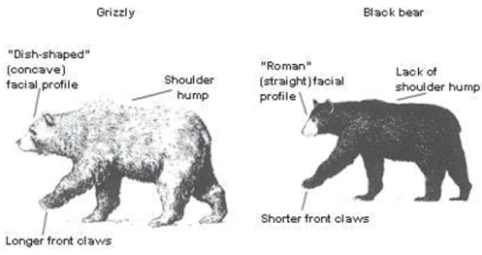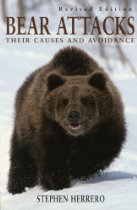| Hiking in Bear Country |
As you're probably already aware, Glacier National Park is bear country, and is home to both black bears and grizzly bears. For those wishing to venture into Glacier's backcountry, one of the first questions that comes to mind is how to have a safe trip while hiking with bears.
One of the best ways to ensure a safe hike is to travel in a group of three or more people. Experts recommend four or even groups of five individuals. The noise from footfalls and talking is usually enough to alert bears of approaching humans. Fortunately Glacier has a fairly extensive program of ranger led hikes that provide hikers with the opportunity to hike in the safety of a group. These ranger led hikes are offered during the summer months, provide inside knowledge of the park and natural world, and visit a variety of destinations throughout the park. You can click here for a schedule.
Short of hiking with a large group, the best thing you can do is learn how to avoid a surprise encounter with a bear, identify the difference between black and grizzly bears, what you should do if you see one on the trail, and what you can do if a bear acts aggressively towards you.
Just to keep things in perspective, though, bear encounters are very rare. Consider that roughly two million people visit Glacier each year, and more than one million venture into the backcountry. On average, there are only one or two non-lethal bear "incidents" in a given year. And, there have only been 10 bear related fatalities in the history of the park (all of those have occurred since 1967). Only three of those fatalities involved hikers, and at least two of those were solo hikers.
Avoiding Surprise Encounters
Noise is your best friend when it comes to avoiding bears while out on the trail. Bears will usually move out of the way if they hear people approaching. Shouting out "hey bear" and clapping hands loudly every few minutes are excellent ways of making your presence known. Many hikers think they can rely on bear bells; however, this is likely to be a mistake. For the most part bear bells are pretty useless. The noise generated by the bells generally doesn't carry well, and are completely useless in windy conditions, near streams, and in open terrain.
 People often assume they don't have to make noise while hiking on a well-used trail. Some of the most frequently used trails in the park, such as Iceberg Lake or Grinnell Glacier, are surrounded by excellent bear habitat. People have been charged and injured by bears fleeing from silent hikers who unwittingly surprised them along the trail. Even if other hikers haven't seen any bears on any given section of trail, don’t assume that bears aren't present.
People often assume they don't have to make noise while hiking on a well-used trail. Some of the most frequently used trails in the park, such as Iceberg Lake or Grinnell Glacier, are surrounded by excellent bear habitat. People have been charged and injured by bears fleeing from silent hikers who unwittingly surprised them along the trail. Even if other hikers haven't seen any bears on any given section of trail, don’t assume that bears aren't present.
Also, don't assume a bear's hearing is any better than yours. Various trail conditions can make it hard for bears to see, hear, or smell approaching hikers. Be particularly careful near streams and waterfalls, against the wind, or in dense vegetation. A blind corner or a rise in the trail also requires special attention.
The best thing to do is to make sure you make a lot of noise, stay alert at all times, and avoid the habit of looking down at the trail all the time.
You should also avoid dead animals, as bears will feed on carcasses for days. If you do come across an animal carcass, retreat the way you came in, and report the finding to a ranger as soon as possible.
Identifying Black Bears and Grizzly Bears
It's important to be able to tell the difference between a black bear and a grizzly bear. This will help you decide your course of action in the event of an encounter with a bear, as the two species will react differently in the same situation.
Color alone isn't a reliable indicator of species. Contrary to their name, black bears also come in brown, cinnamon, and blond. A black bears' facial profile is straighter from the tip of nose to its ears, compared to the dished-in look of the grizzly. They lack the hump, common in grizzlies, and have shorter claws, generally around one and a half inches long. Adult black bear males average around 220 pounds, while adult females average roughly 140 pounds. On average, black bears are two and a half to three feet when standing on all fours.

Grizzlies, like black bears, come in a variety of colors. They can range from blond to nearly black. Sometimes they have silver-tipped guard hairs that give them a "grizzled" appearance. Grizzlies often have a dished-in face and a large hump of heavy muscle above the shoulders. Their claws are around four inches long. Grizzlies usually weigh around 300-600 pounds, but can grow up to 1,400 pounds. Adult grizzlies can be six feet or more when standing on hind legs, and three to four feet when standing on all fours. Based on a multi-year DNA study, it's estimated that there are roughly 300 grizzly bears living within Glacier National Park.
What should you do if you see a bear?
What should you do if you encounter a bear while hiking? Unfortunately, there's no easy answer to that question. Like people, bears react differently to each situation.
Bears may appear tolerant of people, but then attack without warning. A bear's body language can help determine its mood. In general, bears show agitation by swaying their heads, huffing, and clacking their teeth. Lowered head and laid-back ears also indicate aggression. Bears may stand on their hind legs or approach to get a better view, but these actions are not necessarily signs of aggression. The bear may not have identified you as a person and is unable to smell or hear you from a distance.
I strongly urge you to watch the Bear Safety video on the Glacier website. Park Wildlife Biologist John Waller discusses bear behavior and demonstrates some of the things you can do if you encounter a bear on the trail.
Also, for the safety of other hikers, it's best to report any bear sightings to a ranger as soon as possible.
What if a bear acts aggressively towards you?
The vast majority of bear attacks have occurred because people have surprised a bear. In this type of situation the bear may attack as a defensive maneuver.
In rare cases bears may attack at night or after stalking people. This can be very serious because it often means the bear is looking for food and is preying on you. If you are attacked at night, or if you feel you have been stalked and attacked as prey, try to escape. If you cannot escape, or if the bear follows, use pepper spray, or shout and try to intimidate the bear with a branch or rock. Do whatever it takes to let the bear know you are not easy prey.
If you do surprise a bear, here are a few guidelines to follow that may help:
Talk quietly or not at all; the time to make loud noise is before you encounter a bear. Try to detour around the bear if possible.
Do not run! Back away slowly, but stop if it seems to agitate the bear.
Assume a nonthreatening posture. Turn sideways, or bend at the knees to appear smaller.
Use peripheral vision. Bears may interpret direct eye contact as threatening.
Drop something (not food) to distract the bear. Keep your pack on for protection in case of an attack.
If a bear attacks and you have pepper spray, use it!
If the bear makes contact, protect your chest and abdomen by falling to the ground on your stomach, or assume a fetal position to reduce the severity of an attack. Cover the back of your neck with your hands. Do not move until you're certain the bear has left.
Bear Spray
This aerosol pepper derivative triggers temporarily incapacitating discomfort in bears. It's a non-toxic, non-lethal means of deterring bears. There have been cases where bear spray apparently repelled aggressive or attacking bears. But there are accounts where it didn't work as expected. Factors influencing effectiveness include distance, wind, rainy weather, temperature extremes and product shelf life.
If you decide to carry bear spray, use it only in situations where aggressive bear behavior justifies its use. Bear spray is intended to be sprayed into the face of an oncoming bear. It is not intended to act as a repellent.
Do not spray gear or your camp with bear spray.
Under no circumstances should bear spray create a false sense of security or serve as a substitute for standard safety precautions in bear country.
Also, be aware that you may not be able to cross the U.S./Canada border with some brands of pepper spray. Canadian Customs specifications require that all canisters of pepper spray be labeled for use on bears. They will not allow small canisters designed to deter human attackers into the country.
Additional Information
For more information on bear behavior, ecology, and management in Glacier, please click here.
For more in-depth information, the Alaska Department of Fish and Game has some excellent and valuable information concerning Bear Safety, Awareness & Avoidance on their website. The page covers an array of issues regarding bears, including understanding bear behavior, how to react to bear encounters, bear deterrents, and how to avoid bear problems. There's a lot of very useful information here.
The Montana Fish, Wildlife and Parks website also has useful information.


